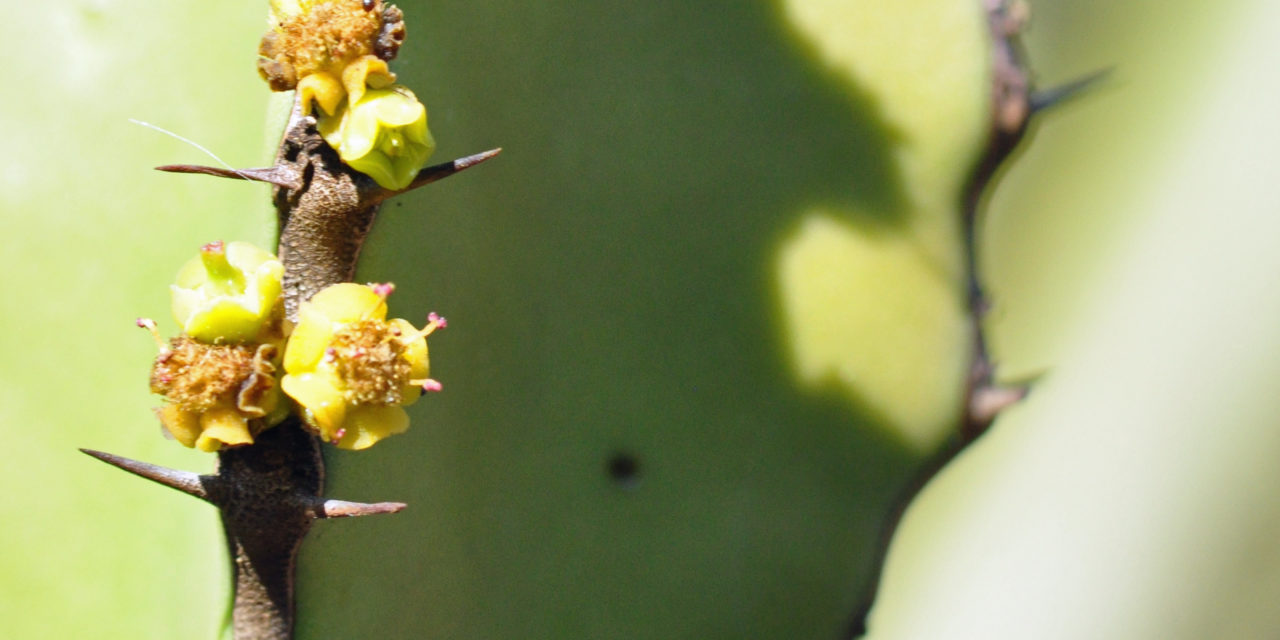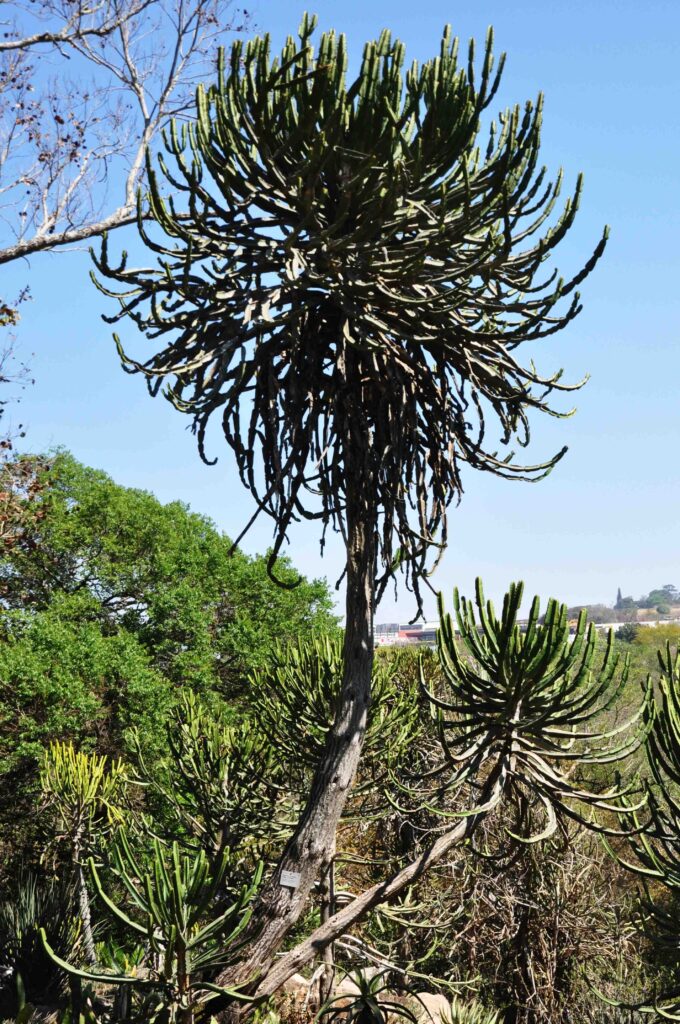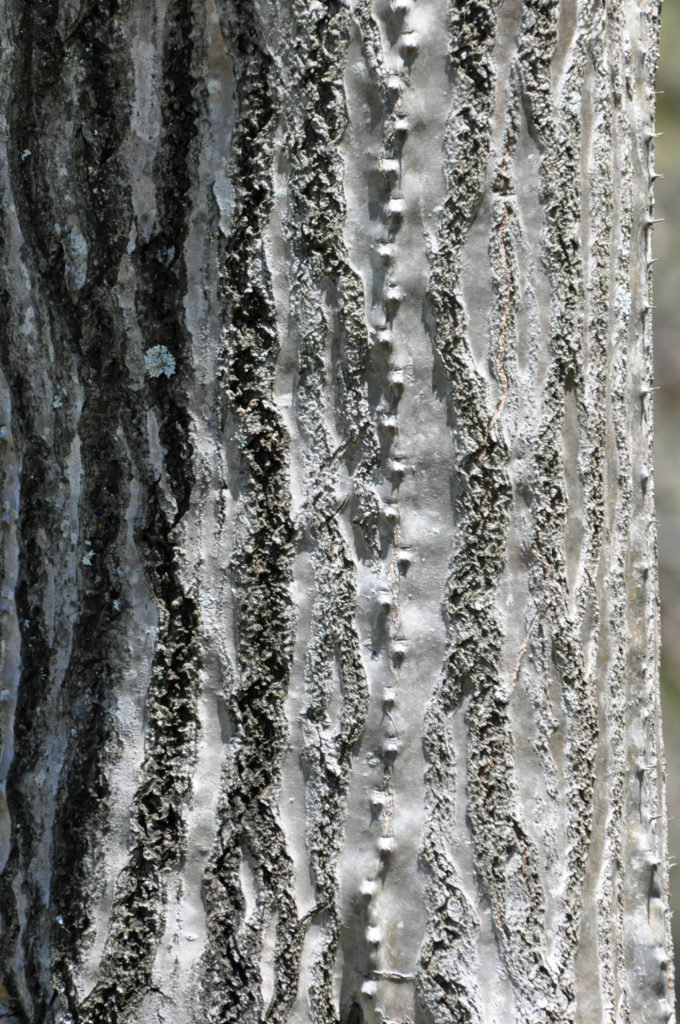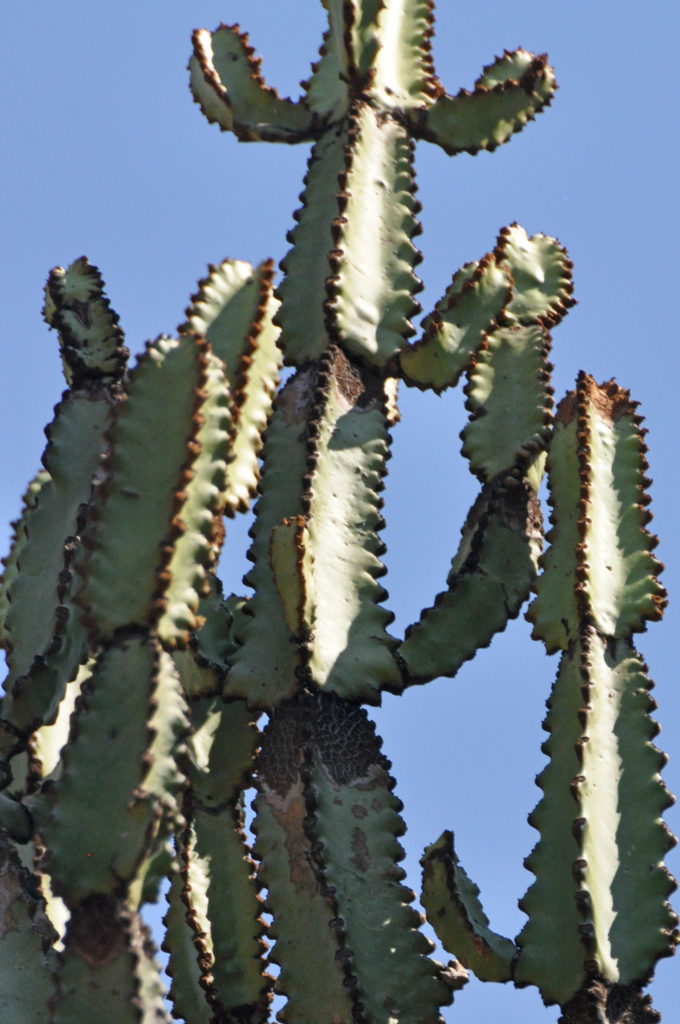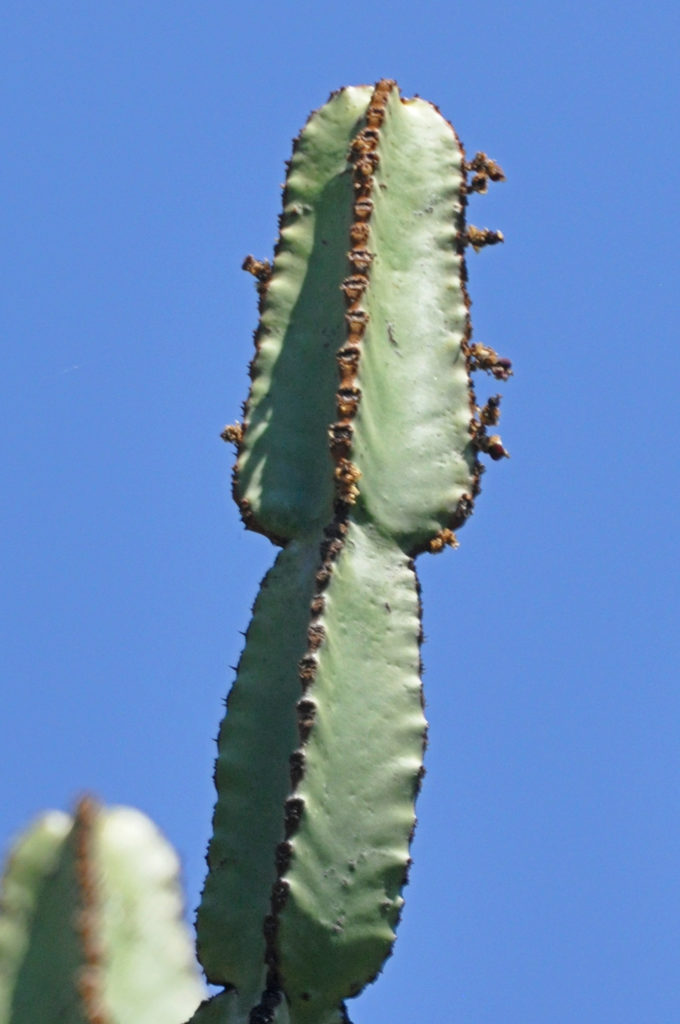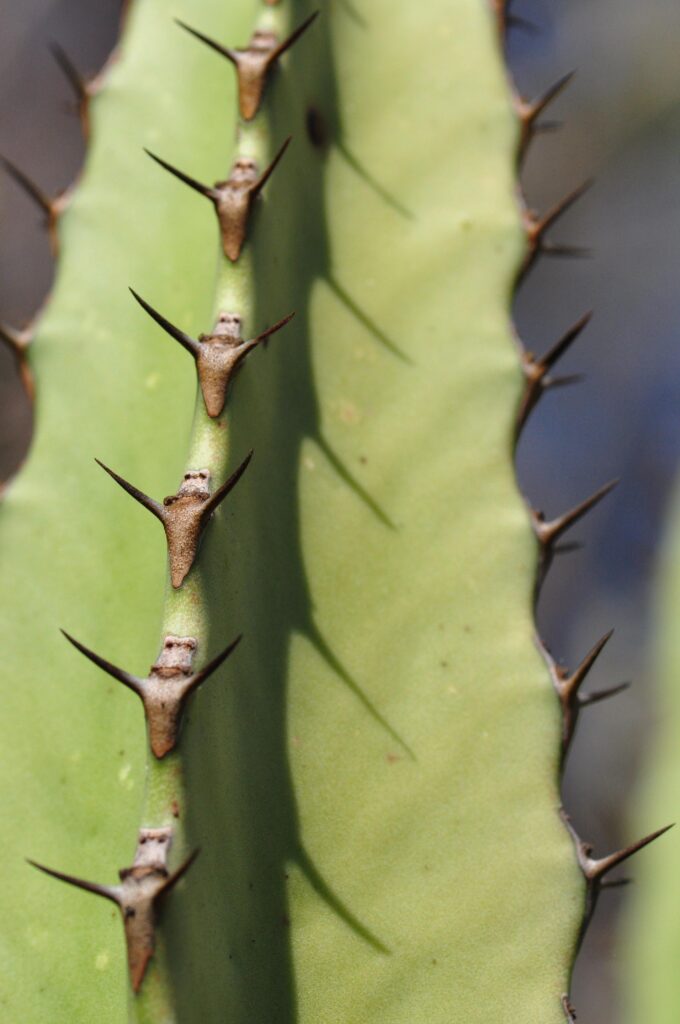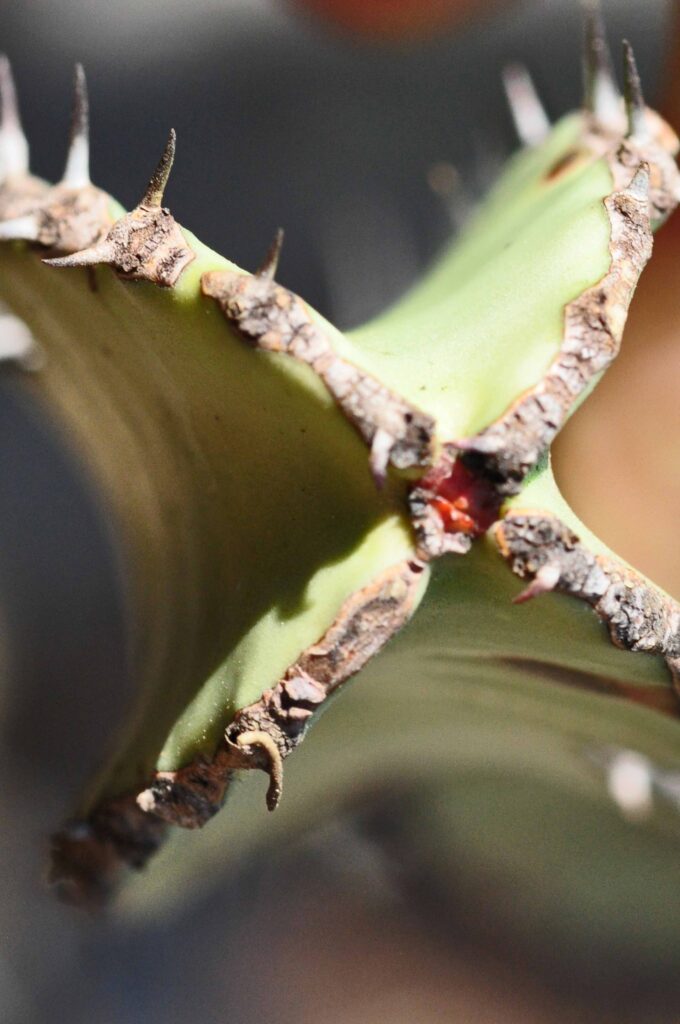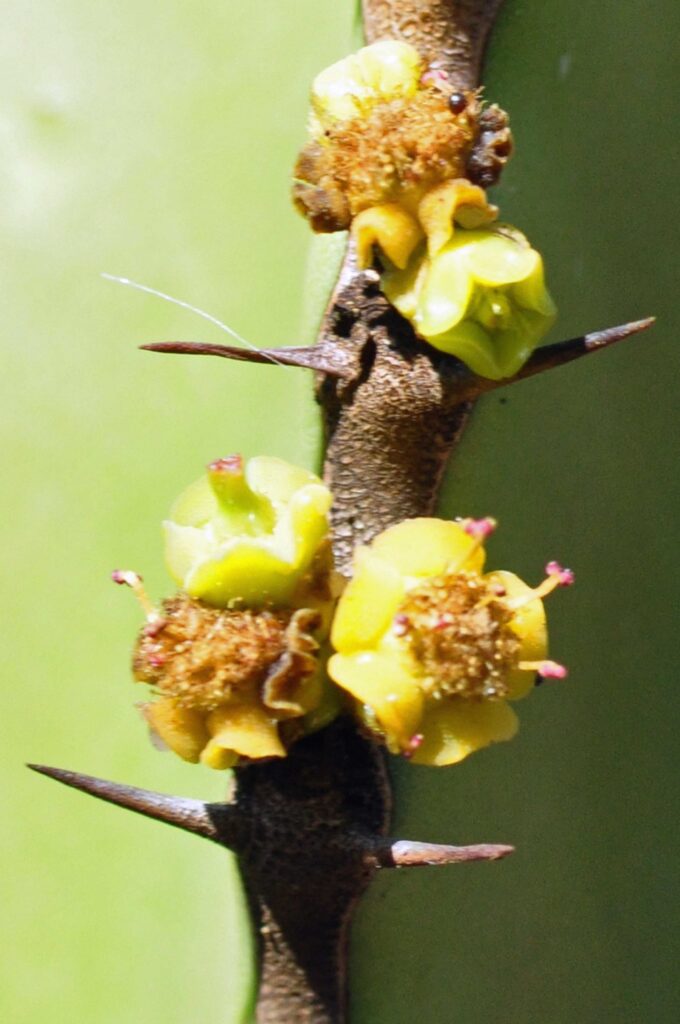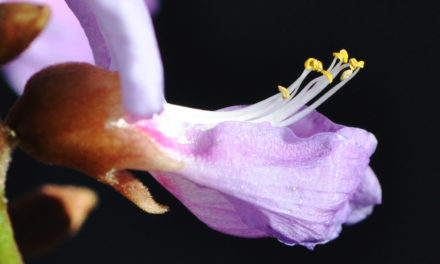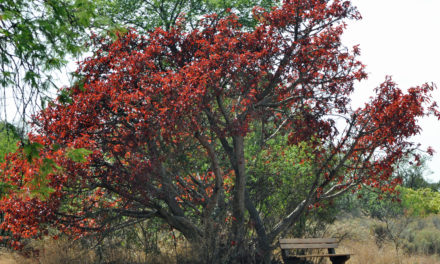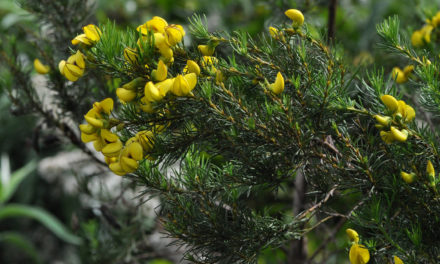General Info – summary
This Tree – up to 10m high. The stem has small terminal branches. Caustic latex is present. Young green stems do photosynthesis & have paired spines. The Leaves are absent or fall early. Regular, greenish yellow Flowers are in a cyathium and lack a perianth. Each single male flower has a one stamen. Single female flowers have a superior ovary with 3 styles. The Fruit is a 3-lobed, stalked, dehiscent capsule.
Description
Euphorbia confinalis
SA Tree No. 345.
Common names: (Afr) Lebombo-naboom, Lebombonaboom. (Eng) Lebombo Candelabra Tree, Lebombo Euphorbia. (siSwati) Unhlonhlo.
Family Euphorbiaceae (Euphorbias family e.g., the exotic poinsettia – Euphorbia pulcherrima). This family has about 275 genera and 7 500 species with a very wide distribution. In South Africa, there are 50 genera and 484 species. Apart from Antarctica, members of this family are present in all continents. This family has many herbs, and in the tropics, shrubs and trees, including succulents and climbers, are more common. Local tree containing genera on this website include Croton, Euphorbia, and Spirostachys. Leaves, when present, are usually alternate, simple and stipules usually appear as hairs, glands or spines. The regular plants may be monoecious or dioecious. Inflorescences are situated terminally or in leaf axils. They are mostly in cymes (a broad, more or less flat-topped, determinate flower cluster, with central flowers opening first). Colourful bracts may be present below the flowers.
Name derivation: Euphorbia – after Euphorbus (50BC-AD19): physician to the king of Mauretania (NW Africa). confinalis – on the boarder – referring to the distribution between South Africa and neighbouring countries. This tree was relatively recently found growing near Punda Maria in the Kruger National Park.
Conservation: National Status: L C. (Least Concern). Assessment: Raimondo et al. (2009). In Zimbabwe it is considered vulnerable.
Tree
This sturdy usually single Tree may be branched is up to 10m high, and shaped somewhat like a “disguised” cell phone mast (photo 834). The grey to brown Bark is rough (photo 832). The tree Apex ends with a relatively small spherical crown. Here the small Branches are up to 7cm wide and occur near the apex of the tree. Each year the Lowest of the down pointing terminal branches are shed, resulting in the unbranched Trunk. The highest curved branches point upwards (photo 834). They have 3-5 (usually 4) vertical Wings present (photo 488. In Zimbabwe there are up to 6 wings). Smaller branches tend to be almost square in cross section. Simple paired Spines are up to 7mm long and are only present on younger parts. They arise on horny bases called Spine shields (photo 487). In this plant, the spine shields are stout, conspicuous and usually separated. Above this, near the end of the spine shields are a pair of relatively small spines (photo 487). Caustic milky Latex may be present. This possibly evolved as a deterrent to herbivores. Plants are succulent and cactus like, but the true cactus lacks the paired spines and the caustic latex that is present in this Euphorbia. The mainly unbranched trunk helps to distinguish it from Euphorbia triangularis.
- 834. 2014/09/15. Lowveld NBG. Photo: David Becking.
- 832. 2014/09/15. Lowveld NBG. Photo: David Becking.
- 837. 2014/09/15. Lowveld NBG. Photo: David Becking.
- 833. 2014/09/15. Lowveld NBG. Photo: David Becking.
- 487. 2017/08/15. Pretoria NBG. Photo: David Becking.
- 488. 2017/08/15. Pretoria NBG. Photo: David Becking.
Leaves
The Leaves either are absent or fall early. This is a possible adaption to the dry environment. However, the green young Stems can photosynthesise (photo 487 above).
Flowers
The small, greenish-yellow to yellow Flowers are situated just above the spines on the wing ridges (photo 490). Here what appears as a flower is actually a whole Inflorescence called a Cyathium (this false flower is the euphorbia inflorescence). Cyathia usually have 4 or 5 Involucral Bracts (whorl of bracts present at the base of an inflorescence). There have brightly coloured nectar glands occurring at the cyathium rim. There is no Perianth (the 2 floral envelopes considered together; a collective term for the calyx and corolla) present. The male flowers are in groups, opposite the yellow involucral bracts. Each Male Flower is reduced to a single Stamen. Here the 2 Theca (pollen sacs) are longitudinally dehiscent. The single Female Flower has a superior Ovary with 3 Styles (red and protruding in the lower photo 490). Each of the 3 locules (cavities within the ovary) has one pendulous ovule. The attractive inflorescence flowers are insect pollinated. (May-Aug).
- 490. 2017/08/15. Pretoria NBG. Photo: David Becking.
Fruit
The dehiscent, 3-lobed, ripening to a deep-red Fruit is a small Capsule (a dry fruit resulting from the maturing of a compound ovary, which usually opens at maturity by one or more lines of dehiscence). The capsule is up to 1cm wide and is woody when mature and has a long peduncle (stalk of flower cluster). The capsule splits open along the inner face to release the Seeds. (Jul-Oct).
Distribution & Ecology
This relatively rare Tree is usually located at relatively low altitudes. They often occur in dry areas, on rocky outcrops, alluvial soil and in deciduous woodlands and rocky hills e.g., the Lebombo Mountain range. In South Africa, they occur in Limpopo and Mpumalanga. Examples are visible at Nkumbe View Site – south of Tshokwane in the Kruger National Park. This impressive View Site is perched about 100m above the surrounding landscape. These trees also occur in Eswatini (Swaziland), south- eastern Zimbabwe, south-western Mozambique. Their growth form enables conservation of water. The stems – especially the younger ones are green and photosynthetic, compensating for their lack of leaves. Some birds feed on the Fruit.
Ethnobotany
Reproduction is by Seed or Truncheons (stem cutting from a selected plant – used to produce genetically identically new plants) but must not be over-watered. Due to the poisonous sap / latex, this plant must be handled with care. It can cause blistering, allergic reaction or even blindness. The latex is used to stun fish. Do not use this fallen wood for making a braai or for heating in a fireplace.
References
Archer, R.H. & Victor, J.E. 2005. Euphorbia confinalis R.A.Dyer. National Assessment: Red List of South African Plants version. Accessed on 2024/08/02.
Burrows, J.E., Burrows, S.M., Lotter, M.C. & Schmidt, E. 2018. Trees and Shrubs Mozambique. Publishing Print Matters (Pty) Ltd. Noordhoek, Cape Town.
Coates Palgrave, M. 2002. Keith Coates Palgrave Trees of Southern Africa. edn 3. Struik, Cape Town.
Lawrence, G. H. M, 1951. Taxonomy of Vascular Plants. The Macmillan Company, New York. Tenth Printing 1965.
Palmer, E. & Pitman, N. 1972. Trees of southern Africa. Balkema, Amsterdam, Cape Town.
Schmidt, S. Lotter, M. & McCleland, W. 2002. Trees and Shrubs of Mpumalanga and the Kruger National Park.
van Wyk, B. & van Wyk, P. 1997 Field guide to Trees of Southern Africa. Struik, Cape Town.
http://www.llifle.com/Encyclopedia/SUCCULENTS/Family/Euphorbiaceae/21567/Euphorbia_confinalis
http://www.zimbabweflora.co.zw/speciesdata/species.php?species_id=135780
http://posa.sanbi.org/flora/browse.php?src=SP

